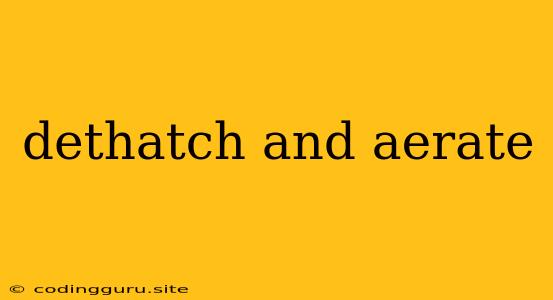Dethatching and Aerating Your Lawn: A Guide to Healthier Grass
A lush, green lawn is a source of pride for any homeowner. However, achieving and maintaining this ideal often requires more than just regular mowing. Two key practices that play a crucial role in lawn health are dethatching and aerating. These processes work together to address common lawn problems, ultimately leading to a more vibrant and thriving green carpet.
What is Dethatching?
Dethatching is the removal of thatch, a layer of dead grass, roots, and other organic matter that builds up on the soil surface. While a thin layer of thatch can be beneficial, excessive buildup can suffocate the lawn, preventing air, water, and nutrients from reaching the roots. This leads to a variety of problems, including:
- Poor water and nutrient absorption: Thatch acts as a barrier, hindering the flow of water and nutrients to the roots.
- Reduced root growth: Limited access to vital resources inhibits the healthy development of root systems.
- Disease and pest susceptibility: A thick thatch layer provides an ideal environment for disease-causing organisms and pests to thrive.
- Uneven growth: The build-up can lead to patchy, uneven growth, affecting the overall appearance of the lawn.
How Often Should You Dethatch Your Lawn?
The frequency of dethatching depends on various factors such as:
- Climate: Warmer climates with high humidity tend to produce more thatch.
- Grass type: Some grass types, like fescue and bluegrass, are more prone to thatch buildup.
- Fertilization practices: Excessive use of nitrogen fertilizers can contribute to thatch formation.
Typically, you should dethatch your lawn once every 2-3 years if you have a moderate amount of thatch. However, if you notice significant thatch buildup, you may need to dethatch more frequently.
How to Dethatch Your Lawn
You can dethatch your lawn using a variety of methods:
- Rake: This is a manual option suitable for small lawns or light thatch build-up.
- Power rake: A power rake is a motorized tool that uses rotating blades to remove thatch. It's effective for removing thicker layers of thatch.
- Vertical mower: This specialized tool is similar to a power rake but uses a set of vertical blades to cut through the thatch layer.
It's important to choose the right tool for the job and to use it carefully to avoid damaging the grass.
What is Aerating?
Aerating is the process of creating small holes in the soil, improving airflow and drainage. These holes allow air, water, and nutrients to reach the roots more effectively, promoting healthy growth.
Aerating is particularly important for compacted soil, which can restrict root growth and lead to a decline in lawn health.
Benefits of Aerating
Aerating offers a range of benefits:
- Enhanced drainage: The holes created by aerating allow water to penetrate the soil more easily, reducing waterlogging and preventing root rot.
- Improved air circulation: Aerating increases the amount of oxygen available to roots, boosting growth and vigor.
- Better nutrient absorption: Aerating helps nutrients reach the roots more efficiently, improving their absorption and overall health.
- Thicker and healthier turf: With improved access to water, air, and nutrients, roots can grow deeper and stronger, leading to a thicker and more resilient lawn.
How Often Should You Aerate Your Lawn?
The frequency of aerating depends on the condition of your soil and grass type. Here's a general guideline:
- Compacted soil: Aerate your lawn annually.
- Heavy traffic areas: Aerate these areas more frequently, up to twice a year.
- Clay soil: Aerate every 2-3 years.
How to Aerate Your Lawn
You can aerate your lawn using a variety of tools:
- Core aerator: This tool removes plugs of soil, creating holes in the lawn. It's the most effective method for aerating compacted soils.
- Spike aerator: This tool uses spikes to penetrate the soil, but it doesn't remove any soil. It's suitable for lighter aerating tasks.
Combine Dethatching and Aerating for Optimal Lawn Health
For optimal results, consider combining dethatching and aerating in the same season. Dethatching first will allow the aerator to work more effectively by reaching the soil more easily.
Tips for Dethatching and Aerating
- Best time to dethatch and aerate: The ideal time is usually in the early fall or late spring.
- Proper timing: Avoid dethatching and aerating when the ground is too wet or too dry.
- Water thoroughly: After dethatching and aerating, water your lawn thoroughly to help the grass recover.
- Fertilize: Apply fertilizer after dethatching and aerating to provide nutrients for growth.
Conclusion
Dethatching and aerating are essential practices for maintaining a healthy and thriving lawn. By removing excess thatch and improving soil aeration, these processes help to create the optimal conditions for strong root growth and a beautiful, green lawn.
Remember to choose the right methods and timing for your lawn's specific needs. With proper care, you can enjoy a lush and vibrant lawn for years to come.
